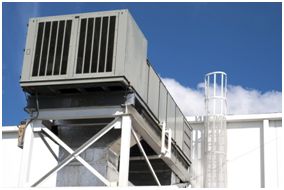Outside Air Humidity
Outside Air Humidity
Having an accurate outside humidity and temperature sensor can save you significantly on energy cost.

Most air handling units (AHUs) use what is called an economizer cycle. This is when outside air is mixed with the return air to cool the building dependent upon the outside temperature. However, if the air is too dry and requires humidification to accomplish this process, your cost savings may have been eliminated due to the AHUs humidity control, which provides excessive steam for this humidification procedure to take place. Consequentially, sometimes based on weather conditions, your economizer may just be costing you money instead of saving it.
Proper Humidity / Temperature Condition.
Outside air is continuously used in AHUs year-round. In the summer warm air is brought in to provide better indoor air quality. Conversely, during the winter months outside air is required to provide cool air to eliminate heat gain from electrical equipment, lighting, and occupants. The economizer cycle is constantly trying to maintain a typical set point of 55 to 60 degrees F. This is done by mixing outside air with the return air from the building. There is a high-limit control on the economizer to control when this mixture is no longer saving energy. If your air handling unit is equipped with a spray chamber then this point is at 75 degree F and 50% relative humidity (RH). For other units this point is 75 degree F and 40% RH. This is why an economizer can significantly decrease your buildings energy cost; however, this savings is dependent on your humidity and temperature sensor. If this sensor fails or is not accurate it could cause your cooling / heating cost to become elevated and you may never even realize you're paying extra on your energy bills each month.
Types of Outdoor Humidity sensors.
The most common type of humidity sensor is a polymer capacitance humidity sensor. In most applications this type of sensor is left exposed to the elements leaving it vulnerable to damage from dust, dirt, bugs, etc. It also requires that the sensor be mounted on the north side of the building out of direct sunlight. Even though this polymer sensor can be totally saturated and still function properly after it dries out, it still presents long-term reliability issues.
To resolve this issue some manufactures have chosen to use a sintered filter for the sensor to protect it from foreign entities. This too can still present many issues if not mounted properly; it may even see elevated temperatures due to the metal filter around the sensor.
Often times when trying to mount your outdoor relative humidity sensor, you may not have a north side location to work with or there could be a reflective glass building on that north side too. As well, your air handler may not be close to the north side of the building causing installation costs to rise; due to the time of setup and cost of running conduit.

Dwyer has introduced the Series RHRS (outside air humidity radiation shield). This shield is designed to fit on the Dwyer Series RHP. It can also be factory ordered and installed on the RHP unit itself. This gives outstanding protection to the relative humidity/temperature sensor and also improves performance. The RHRS can be mounted anywhere on the building, even directly to the air handler. This will save you in three ways: installation time, less maintenance calls, and of course always having accurate readings so your AHU to operate properly to save every penny in your energy cost.

